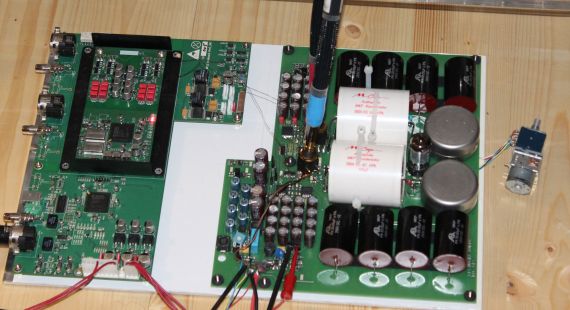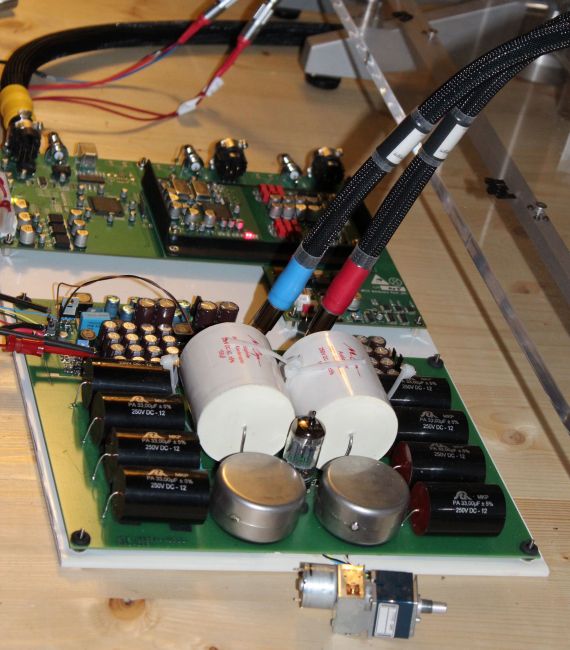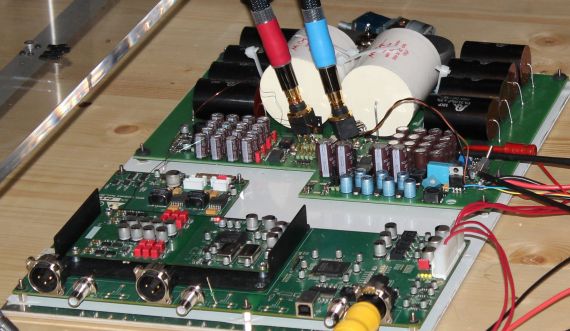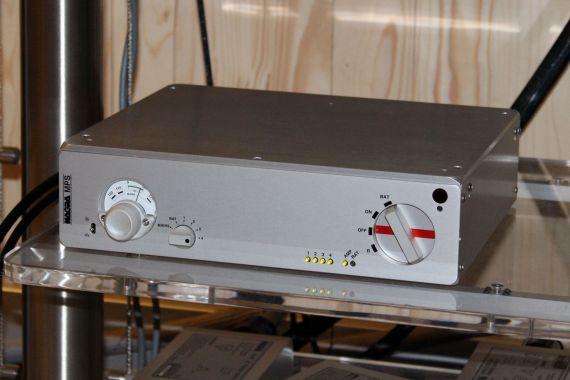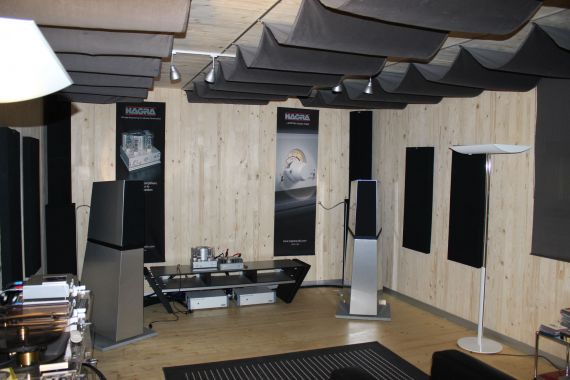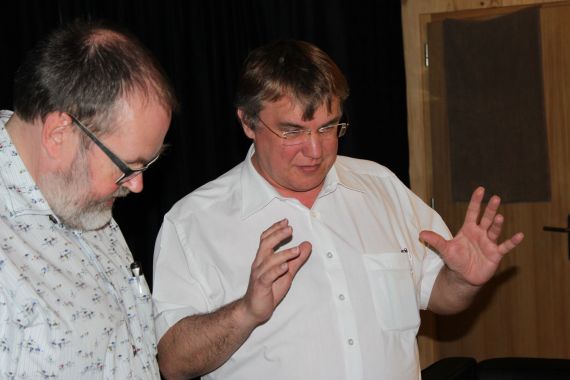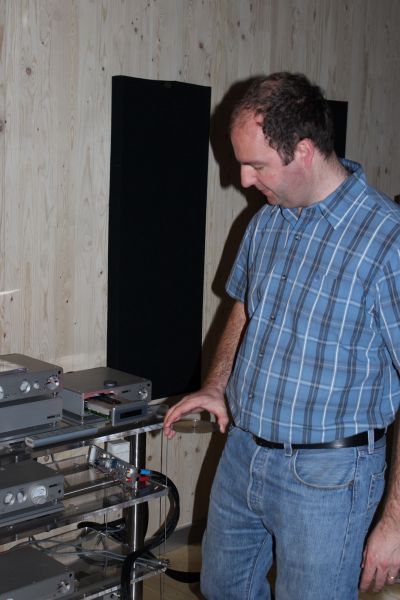|
You are reading the older HTML site
Positive Feedback ISSUE 67
Prototype Test: The Nagra DAC Project
[Photographs courtesy of Dirk Sommer/HiFi Statement] Prior to each year's High-End show in Munich, manufacturers are working under much pressure to finalize new products or prototypes for official unveilings at the show. Nagra managed to put just enough finishing touches on an upcoming DA converter that I was able to test drive it with a few CDs I am familiar with.
The converter is still waiting for its final case. On the left of the board sits the input stage and the converter board, developed by Andreas Koch. That's quite the analog output stage. The caveat being that this particular prototype was only able to playback native Compact Discs fed via its AES/EBU input, for the simple reason that Nagra's own USB input wasn't quite ready yet for prime time. In Munich then, Nagra plans to show off their latest unit that will accept native Hi-Res PCM in 24/192, DXD, DSD and double DSD. As for the playback software itself, the new DAC – for which an official name has yet to be found (feel free to send your suggestions to the editor [email protected]) – will definitely be future proof. The DAC's DA conversion was a development of none other than Andreas Koch, who as many Hi-Fi fans know, is behind his own company's well received Playback Designs players, and of course his work behind the Sonoma studio system, which was created specifically for the production of SACDs for Sony. Hifistatement readers can read the "Basics" on the future of the DSD format
Between the transformer and the tube: the sound of the new DACs Nagra used the specifically designed, supplied circuits, but only partially: following the delta-sigma converter, the signal goes directly through a tremendously complex, Philipe Chambon designed circuit. Here the signal passes through an impedance transformer that performs no current or voltage amplification, and then passes on to a very complex intermediate transformer. Even the iron used in the process is different from the commonly used varieties. One result of the effort: from ten hertz to 100 kilohertz the transformer operates almost phase linear. From the secondary side, the signal then proceeds to a version of a military grade ECC82 tube, which, just like the impedance converter, doesn't amplify or use any feedback. The necessary amplification is purely done through the interstage transformer. The current version uses Mundorf capacitors, but there are still experiments with tin /Teflon capacitors, which are manufactured specifically for Nagra.
Right on the board you'll find the XLR and the USB input jacks. The custom-digital board is above the actual board. Of course, analog and digital sections utilize separate external power supplies. These may be the ones used also for Melody and Jazz or the new MPS power supply can be purchased, which is housed in the Nagra typical chassis featuring the characteristic "meter" eye and can supply up to four components with power. Following the two power supplies are at least 22 voltage supplies providing sufficient power for the individual modules. Philippe Chambon does not want to rule out that there may also be two more in the production version. The timing of the various switching power supplies is synchronized by a master clock; the time signal is distributed optically to ensure galvanic isolation of the power supply.
The Nagra MPS usually supplies four Nagra units with clean energy, but the new Nagra DAC claimed two of its outputs. During the design of the analog output stage, Philippe Chambon utilized Nagra's other famous model, the Nagra IV-S. He compared the spectral harmonics of songs recorded with the IV-S to the ones reproduced by the DAC be able to align the DACs overall sound as closely as possible to these tapes. Unfortunately, I have committed myself to not disclose any further details on this subject matter. This commitment however, does not preclude me from sharing a few thoughts and samples on the overall sound quality of this new DAC that I got while in Nagra's listening room. By the way, some insights and views of the wooden room-in-room construction at Nagra headquarters can be found in the company report published last year.
The Nagra listening room with the Verity Audio Lohengrin II's. The chain in the listening room consisted of a CDP CD player, which supplied the data for the new DAC. This was connected via a potentiometer with an MSA transistor output stage, which was used to drive two Verity Audio Lohengrin II loudspeakers. All cables were supplied by Purist Audio Design. Surprisingly, my first test disc gave no clues about the quality of the new DAC. I simply needed a certain amount of time to familiarize myself with the sound of the Nagra listening room: the deepest of bass frequencies still had some small problems; otherwise the system played already at an extremely high level and made it easy to sound like home. By the second and third discs, a more spatially stable image emerged, aided with more precision and image plasticity than I've ever heard from these discs. Dynamics, timbre and timing left nothing to be desired, but did not surpass my previous listening experiences in my own home system.
Nagra developer Philippe Chambon (right) explains technical details to Dirk Sommers (left). The Nagra chain revealed a lot of details that simply sounded better integrated in the musical flow. Here the sound definitely did have more to offer than what I was used to. Also the fourth test disc was a spectacle, impressing again with speed, pressure and rhythm; but the best discipline of the system was the easy to grasp realistic and coherent spatial representation. A quick change to the built-in CDP's DAC and output stage made it clear that this so immensely fascinating spatial representation was really due to the new DAC and output stage. Naturally, I wouldn't balk at a speedy arrival of a formal test sample at my own house. Considering that this fantastic sound performance was generated by data from a CD, and not a USB input or streaming Hi-Res files, the one can only say the following: Nagra's DAC project looks to be very promising indeed. PS: The price should be at about € 15,000; with the MPS, it will be 18000 €.
Marketing Director Matthieu Latour made the test of the new Nagra DAC possible at this early date. Statement The prototype of the new Nagra DAC, operating only with CD-level data, offers a representation of space such as I have not previously experienced. Visitors to the High End show in Munich should treat themselves with the presentation of this experience with Nagra's even more refined prototype. I am most certainly looking forward to a formal review in the near future.
Nagra Distributor
Gaudios KG
|

